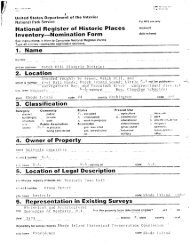1 Dr. Jonathan Prude, Emory University “The Great Transformation ...
1 Dr. Jonathan Prude, Emory University “The Great Transformation ...
1 Dr. Jonathan Prude, Emory University “The Great Transformation ...
You also want an ePaper? Increase the reach of your titles
YUMPU automatically turns print PDFs into web optimized ePapers that Google loves.
13strictures against child labor, there were also whole families. Some of the unattached individualswere sent by their farming families in the expectation that, like outwork, factory berths wouldyield wages that would be funneled back to the operatives’ households of origin. But unattachedindividuals and perhaps some family groups as well were also among those who no longerexpected to inherit land--or in some instances simply found farming unattractive. And yet others,individuals and families alike, and drawn from both cities and countryside, were poor: thehardpressed victims of reversed fortunes or chronic neediness. Notably, though, by the 1820soperatives in the southern New England mills, whatever their original backgrounds,encompassed veterans: not life-long factory workers necessarily but operatives who arrived atfactory villages with prior experience in millwork and with expectations of continuing in suchlabor for a while. Even given the gender and age differentiations of millwork (with men, women,and youngsters assigned to separate areas of production), veterans were soon thickly representedin southern Yankee factory villages: “I can spin,” wrote an operative to a prospective employerin 1827, “[and have] one boy that can spin...another his large enough and one that has benfeeding the breaker in the carding room.”They came, this variegated troop, and in some cases they lingered, because the jobs wereavailable, because the work, much of which involved monitoring machines, was not obviouslyphysically taxing, and because the wages were fairly good. In 1832, the daily pay doled out bySlater’s southern Massachusetts mills ranged from 88 cents for men to 43 cents for women and25 cents for children, which averaged out to roughly $160 a year. That said, millwork wasscarcely a walk in the park. It often meant working in sharply varying temperatures and oftenamidst teeth-jarring noise few would have encountered before. Moreover, if the work was notobviously strenuous, the task of watching continuously running technologies was still stressful.And it was especially stressful because of factory work schedules. The twelve-hours daysstipulated by mills in these years would not have been unfamiliar to rural New Englanders. Butfactory days stood out because there were few breaks, because they were measured meticulouslyby the clock, and above all because they were tightly supervised.















